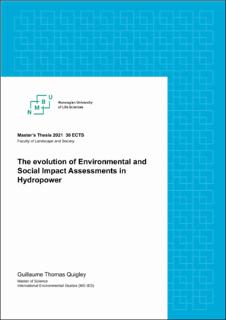| dc.description.abstract | Environmental and Social Impact Assessments or ESIA’s are one of the main project decision-making tools in use to address environmental and social externalities related to project development. They have evolved in response to the ever-growing need to better acknowledge and mitigate negative environmental and social impacts of human development that began with the so-called environmental awakening in the 1960s. This movement led to the first impact assessment tool being developed and implemented in the USA under the National Environmental Policy Act (NEPA) and is known as the Environmental Impact Assessment (EIA). The ESIA today is found in numerous national legislations, international agreements, lending institution requirements and is viewed as key to addressing the problem of sustainable development. This study will try and understand how ESIA has evolved by using hydropower development as a case study. This is particularly relevant as hydropower faces a paradox in that they are viewed as bought merely a renewable source of energy and a source of negative local or regional environmental and social impacts. Through a literature review and interviews with relevant experts in the field, this study will look at the evolution of the ESIA in hydropower to better understand what has made the ESIA what they are today, how they fit into the changing agendas and how they address the issue of sustainability in hydropower. The findings were that the evolution of the ESIA was driven by changing environmental agendas due to growing awareness of the scope of environmental and social issues. Furthermore, the interaction between different actors such as legislators/regulators, developers/investors, practitioners, academics, and civil society is what has shaped the ESIA into what it is today. Despite this long evolution, however, in practice ESIA’s have encountered some limitations due to scoping, cumulative impacts, timing of their intervention and putting them properly into practice in hydropower development projects. This has led to questions in the role of ESIAs regarding the future of sustainable hydropower development. The hydropower industry is evolving into a more integrative approach where Strategic Environmental Assessment (SEA) and Basin Management Plans (MBP’s) are being strongly advocated by key international and regional actors in hydropower such as the International Hydropower Association (IHA) and the Mekong River Commission (MRC). ESIA’s are still an integral part of hydropower development and are developing new methods of valuation to better address some limitations and to address sustainability for better cost-benefit analysis. These two organizations cited above, along with international lenders (World Bank, International Finance Corporation, EIB etc.) have over the past two decades advocated, integrating project-related ESIA’s into a larger-scale assessment that allows for better sustainability assessment of hydropower development on a national or regional scale and thus satisfy their safeguard policies that allows them to confirm or not whether they will lend money to developers or not. This is in line with the growing understanding and acknowledgment that the scope of environmental and social issues is usually beyond what a single project assessment can address. | en_US |

